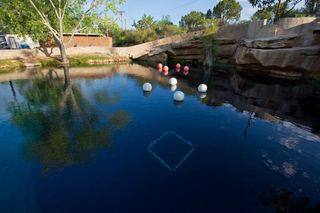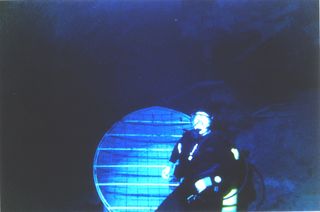
Dangerous Depths: Divers to Explore Secret Underwater Cave

In 1976, two students died while exploring the "Blue Hole," an underwater cave connected to a deep lake in Santa Rosa, N.M. Shorty thereafter, police divers collected the students' bodies and made rough, incomplete sketches of the first part of the cave.
After that, the entrance to the cave was covered with a grate to prevent anybody else from getting in, and since then, nobody has entered it — until now.
Today (Sept. 13), the grate that seals off the cave will be opened to a special team of divers from the ADM Exploration Foundation to explore what lies beyond. Divers from the group, which has explored thousands of caves in the Americas, will produce a detailed map of the Blue Hole cavern, as well as take video of the expedition to make into a documentary, said Walter Pickel, a diver and logistics officer for ADM (which stands for Advanced Diver Magazine).
Although police divers made measurements in the '70s suggesting that the cavern is about 225 feet (70 meters) deep, it's not known how far back it goes, or if it gets deeper, said Richard Delgado, the tourism director for the city of Santa Rosa. Delgado said he wagers it's connected to other caves in the area, which is known for having several deep lakes consisting of flooded caverns and artesian wells, in which pressurized water seeps up from below. [The 7 Longest Caves in the World]

"We really have no idea what exists beyond the grate," Delgado told LiveScience.
As the divers explore the cave they will carry a long line with them. The line measures how far they gone and how far apart certain landmarks are. The direction, or bearing, of the line is also recorded, Pickel said. These measurements, along with high-definition video, will allow them to recreate and make drawings of the cave, he said. A collaborating cartographer will use other methods to measure the caves' dimensions, he added.
The ADM team travels to caves around the world, often getting permission from private landowners to enter their caves. In return, ADM makes maps of what's inside them, Pickel said.
Sign up for the Live Science daily newsletter now
Get the world’s most fascinating discoveries delivered straight to your inbox.
The "Blue Hole" was formerly a sinkhole caused by the dissolution of underground limestone and gypsum, according to the New Mexico Bureau of Geology and Mineral Resources. Many of the area's caves and sinkholes were formed by the same process. Groundwater is plentiful in the region, as it lies on the western edge of the Ogallala Aquifer, Delgado said.
Email Douglas Main or follow him on Twitter or Google+. Follow us @livescience, Facebook or Google+. Article originally on LiveScience.
Most Popular


